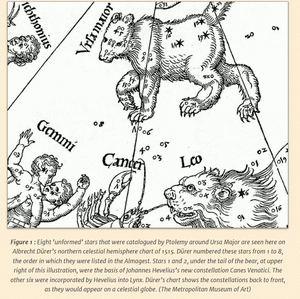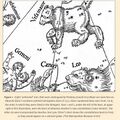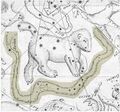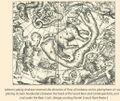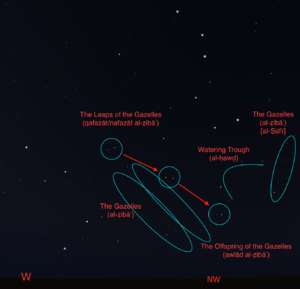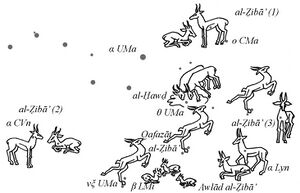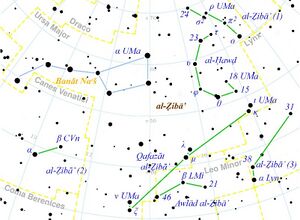Jordanus: Difference between revisions
(added Coronelli 1693 & 1696) |
No edit summary |
||
| (69 intermediate revisions by 6 users not shown) | |||
| Line 1: | Line 1: | ||
[[File:KEE Jordanus piece hi.JPG|alt=historical globe gores (1612)|thumb|Globe gores of the 1612 celestial globe by van den Keere & Plancius on which Plancius introduced his last set of biblically inspired constellations, including Jordanus (highlighted). Note that the year 1625 mentioned in one of the cartouches is not the year of publication but the epoch for which the stellar coordinates were plotted.]] |
|||
[[File:Jordanis Constellation Position.jpg|alt=star chart|thumb|Jordanis Constellation Position on a modern map (CC BY Ultima Thulean)]] |
[[File:Jordanis Constellation Position.jpg|alt=star chart|thumb|Jordanis Constellation Position on a modern map (CC BY Ultima Thulean)]] |
||
[[File:Jordanus.jpg|thumb|Jordanus in Jakob Bartsch's Planisphaerium Stellatum 1661]] |
[[File:Jordanus.jpg|thumb|Jordanus in Jakob Bartsch's Planisphaerium Stellatum 1661]] |
||
[[File:PreJordanus in Duerer Ian.gif|alt=detail of star chart, free stars highlighted|thumb|Dürer (1515): Map of Ursa Major with eight free stars south of it. animated GIF highlights them (CC BY SMH)]] |
|||
An obsolete Early Modern constellation made from eight unnamed Ptolemaic stars: Alpha and Beta CVn, Alpha, 31 and 38 Lyncis (according to Toomer), and three fainter stars of uncertain identity. |
|||
An obsolete Early Modern constellation, defined in the movement of Christianizing the sky but inconsistently: Plancius (1612) made it from eight unnamed Ptolemaic stars: Alpha and Beta CVn, Alpha, 31 and 38 Lyncis (according to Toomer), and three fainter stars of uncertain identity. Julius Schiller (1627) used it as a name for [[Hydra]]. |
|||
==Etymology and History== |
==Etymology and History== |
||
It is the name of a (real) river with immense cultural significance, not only as a border between countries but also for several religions. The English word is a Latin loanword, derived from Semitic 'Yard|on' 'flow down' <√ירד reflecting the river's declivity (Hebrew: נְהַר הַיַּרְדֵּן, ''Nəhar hayYardēn'', Arabic: نَهْر الْأُرْدُنّ, ''Nahr al-ʾUrdunn''). |
|||
The extinct constellation "Jordanus Fluvius" or "Jordanis" – the river Jordan – was invented by Petrus Plancius on his 1612 celestial globe.<ref>Ridpath, Ian, "[http://www.ianridpath.com/startales/jordanus.html Star Tales: online edition]".</ref><ref>[https://www.google.com/books/edition/The_Lost_Constellations/u_7NCgAAQBAJ?hl=en&gbpv=1&dq=Jordanus+Fluvius+Ursa+Majoris&pg=PA201&printsec=frontcover Barentine, John C., 2015, ''The Lost Constellations: A History of Obsolete, Extinct, or Forgotten Star Lore'', Springer Praxis Books, Chichester, UK, p. 201-216.</ref><ref>[https://www.obliquity.com/skyeye/88const/Jor.html Harper, David & Stockman, L.M., 2020, "Jordanus Fluvius – The River Jordan"], </ref> The constellation first appeared in print in the book ''Usus Astronomicus Planisphaerii Stellati'' by Jacob Bartsch (1624), as his 26th constellation – "Iordanis" or "Iordanus". In the illustration of "Iordanis" on Bartsch's celestial globe ''Planisphaerium Stellatum...'' (1661), the star Alpha Lyncis appears as one of the prominent stars in the middle of the constellation. The extinct constellation also appeared as "Iordan" on Isaac Habrecht's (1628) ''Planiglobium coeleste et terrestre'', "Fluvius Jordanis" in Carel Allard's (1706) ''Hemisphaerium meridionale et septentrionale planisphaerii coelestis'' and "Ior-Dan" in Corbinianus Thomas' (1730) ''Mercurii philosophici firmamentum firmianum''. John Barentine (2016) notes that most of the area of Jordanis (and its aliases) was carved up in Hevelius's Lynx, Leo Minor, and Canes Venatici, which were subsequently adopted as constellations by the IAU in the 1920s. |
|||
=== |
=== Constellation === |
||
The extinct constellation "Jordanus Fluvius" or "Jordanis" – the river Jordan – was invented by Petrus Plancius on his 1612 celestial globe.<ref>Ridpath, Ian, "[http://www.ianridpath.com/startales/jordanus.html Star Tales: online edition]".</ref><ref>Barentine, John C., 2015, ''The Lost Constellations: A History of Obsolete, Extinct, or Forgotten Star Lore'', Springer Praxis Books [https://www.google.com/books/edition/The_Lost_Constellations/u_7NCgAAQBAJ?hl=en&gbpv=1&dq=Jordanus+Fluvius+Ursa+Majoris&pg=PA201&printsec=frontcover LINK], Chichester, UK, p. 201-216.</ref><ref>[https://www.obliquity.com/skyeye/88const/Jor.html Harper, David & Stockman, L.M., 2020, "Jordanus Fluvius – The River Jordan"], </ref> The constellation first appeared in print in the book ''Usus Astronomicus Planisphaerii Stellati'' by Jacob Bartsch (1624), as his 26th constellation – "Iordanis" or "Iordanus". In the illustration of "Iordanis" on Bartsch's celestial globe ''Planisphaerium Stellatum...'' (1661), the star Alpha Lyncis appears as one of the prominent stars in the middle of the constellation. The extinct constellation also appeared as "Iordan" on Isaac Habrecht's (1628) ''Planiglobium coeleste et terrestre'', "Fluvius Jordanis" in Carel Allard's (1708) ''Planisphaerii Coelestis Hemisphaerium Septentrionale'' and "Ior-Dan" in Corbinianus Thomas' (1730) ''Mercurii philosophici firmamentum firmianum''. John Barentine (2016) notes that most of the area of Jordanis (and its aliases) was carved up in Hevelius's Lynx, Leo Minor, and Canes Venatici, which were subsequently adopted as constellations by the IAU in the 1920s. |
|||
=== Occurrence in historical maps and globes === |
|||
* Bartch, Jacob, 1624, ''Usus Astronomicus Planisphaerii Stellati'', p. 57. |
|||
* Habrecht, Isaac, 1628, ''Planiglobium coeleste et terrestre'', Figura I. |
|||
* van den Keere, Pieter & Plancius, Petrus 1612, celestial globe.<ref>[http://hdl.handle.net/10934/RM0001.COLLECT.130713 Rijksmuseum link].</ref> |
|||
* Cellarius, Andreas, 1660, ''Harmonia Macrocosmica'', Plates 24, 25 & 26. |
|||
* Bartsch, Jacob, 1624, ''Usus Astronomicus Planisphaerii Stellati'', p. 57. |
|||
* Habrecht, Isaac, 1628, ''Planiglobium coeleste et terrestre'', Figura I.<ref>[https://echo.mpiwg-berlin.mpg.de/ECHOdocuView?url=/mpiwg/online/permanent/library/27CWZ8E0&start=351&pn=356 ECHO link].</ref> |
|||
* Cellarius, Andreas, 1660, ''Harmonia Macrocosmica'', Plates 24, 25 & 26.<ref>[https://www.alvin-portal.org/alvin/view.jsf?pid=alvin-record:80900 Alvin link 1], [https://www.alvin-portal.org/alvin/view.jsf?pid=alvin-record:80899 Alvin link 2], [https://www.alvin-portal.org/alvin/view.jsf?pid=alvin-record:80898 Alvin link 3].</ref> |
|||
* Royer, Augustin, 1679, ''Cartes du ciel reduites en quatre tables''.<ref>[https://gallica.bnf.fr/ark:/12148/btv1b8444012m/f1.item Gallica link 1], [https://gallica.bnf.fr/ark:/12148/btv1b5971440s/f1.item Gallica link 2].</ref> |
* Royer, Augustin, 1679, ''Cartes du ciel reduites en quatre tables''.<ref>[https://gallica.bnf.fr/ark:/12148/btv1b8444012m/f1.item Gallica link 1], [https://gallica.bnf.fr/ark:/12148/btv1b5971440s/f1.item Gallica link 2].</ref> |
||
* |
* Brunacci, Francesco, 1687, ''Planisfero del Globo Celeste Arctico & Antarctico''.<ref>[https://gallica.bnf.fr/ark:/12148/btv1b8491352m Gallica link].</ref> |
||
* Coronelli, Vincenzo, 1692, ''Planisfero Settentrionale, corretto, et accresciuto di molte Stelle'',<ref>[https://gallica.bnf.fr/ark:/12148/btv1b84912543 Gallica link 1], [https://gallica.bnf.fr/ark:/12148/btv1b101003934 Gallica link 2].</ref> also on his celestial globes dated 1693 & 1696.<ref>[https://gallica.bnf.fr/ark:/12148/btv1b530665520 Gallica link 1], [https://gallica.bnf.fr/ark:/12148/btv1b53065264t Gallica link 2].</ref> |
|||
* Allard, Carel, 1706, ''Hemisphaerium meridionale et septentrionale planisphaerii coelestis''. |
|||
* Allard, Carel, 1708, ''Planisphaerii Coelestis Hemisphaerium Septentrionale''.<ref>[http://hdl.handle.net/10934/RM0001.COLLECT.702487 Rijksmuseum link].</ref> |
|||
* Thomas, Corbinianus, 1730, ''Mercurii philosophici firmamentum firmianum'', Frankfurt/Leipzig. |
* Thomas, Corbinianus, 1730, ''Mercurii philosophici firmamentum firmianum'', Frankfurt/Leipzig. |
||
=== Transformation of Constellation === |
|||
==Mythology== |
|||
<gallery> |
|||
File:PreJordanus in Duerer Ian hi.JPG|The eight 'external' stars south of Ursa Major in Dürer's star chart 1515, described by [http://www.ianridpath.com/startales/ptolemy-spare.html Ian Ridpath] (highlighted by SMH). |
|||
File:KEE Jordanus piece hi.JPG|Globe gores of the 1612 celestial globe by van den Keere & Plancius on which Plancius introduced his last set of biblically inspired constellations, including Jordanus (highlighted). |
|||
File:Jordanus Habrecht hi.JPG|Jordanus constellation (highlighted) in [https://echo.mpiwg-berlin.mpg.de/ECHOdocuView?url=/mpiwg/online/permanent/library/27CWZ8E0&start=351&viewMode=images&pn=356&ww=0.25&wh=0.2654&wx=0.4614&wy=0.4032 Habrecht, Isaak, Planiglobium coeleste ac terrestre (1666)]. |
|||
File:Jordanus HI 20240816 114638.jpg|Ursa Major on a celestial Globe by Isaac Habrecht (1675), (Dommuseum Hildesheim, Inv.-Nr. 1980-7). Jordanus is drawn with two headwaters labelled "Ior" and "Dan", and the Big Dipper is drawn as a Chariot with Charioteer pulled by three animals (instead of the handle of the dipper). |
|||
File:Jordanus Andreae1724.JPG|Image of the river with its direction of flow reversed by Johann Ludwig Andreae (1724) with description [http://www.ianridpath.com/startales/jordanus.html by Ian Ridpath] |
|||
</gallery> |
|||
==Mythology / Cultural Significance== |
|||
<gallery> |
|||
File:JordanRiver en.svg|The Jordan River. Modified from [http://www.un.org/Depts/Cartographic/map/profile/israel.pdf MAP] Cross-checked with other maps, especially in the area of the Hula swamp and the tributaries ([[commons:File:JordanRiver_en.svg|see Wikicommons]]). |
|||
File:JordanRiver Baptise20230422 152835.jpg|Bethabara at Jordan River (west), CC0. |
|||
File:JordanRiver Baptise 20230422 153142.jpg|Baptism ceremony at Bethabara, Jordan River (west), CC0. |
|||
File:JordanRiver Baptise20230422 153050.jpg|Bethabara at Jordan River (west) where Jesus was baptised (according to Matthew) as ceremonial place, CC0. |
|||
File:JordanRiver Baptise 20230422 153239.jpg|Bethabara at Jordan River (west) where Jesus was baptised (according to Matthew) as ceremonial place, CC0. |
|||
File:JordanRiver Baptise20230422 154044.jpg|Bethabara at Jordan River (west) where Jesus was baptised (according to Matthew) as ceremonial place and with a church visible at the east side of the river, CC0. |
|||
File:20230422 154556.jpg|Probes of Jordan River water are sold as souvenirs, CC0. |
|||
File:Jordan River.jpg|The Jordan River defines the borders between Israel and Jordan. It has rich cultural and historical significance (CC BY SA 2.5 Author: David Bjorgen, from Wikimedia Commons). |
|||
File:JordanRiver Baptise20230422 154038.jpg|Several churches at both sides of the Jordan River, cc0. |
|||
File:20230422 152855.jpg|Jordan River is in a depression: partially below sea-level (CC0) |
|||
</gallery> |
|||
== Arabic Names of the Stars in Jordanus == |
|||
=== '''''al-Ẓibā’''''' in Paul Kunitzsch, ''Untersuchungen zur Sternnomenklatur'', 1961. === |
|||
<nowiki>*</nowiki> 21a. awlād ''aẓ-Ẓibā’'', p. 39:<blockquote>„die Jungen der Gazellen“. Ibn Qutayba 67, 1 (bei den unter Mondstation 14 mitbehandelten Sternen): ''kawākib ṣiġār fī-mā bayna ẓ-ẓibā’ wa''-l-''qafazāt'' „kleine Sterne zwischen ''aẓ-ẓibā’'' [nr. 329] und ''al-qafazāt'' [nr. 211a]“. Ṣūfī 34, 1f. und 18‒20 zählt besonders den 5. bis 8. externen Stern im ptolemäischen Bildes Großer Bär = Fl. 10 Leonis Minoris; IX, 115; VIII, 245; Fl. 31 Lyncis hierzu, sowie all die zahllosen Sterne, die schwächer sind als Größe sechs und die Ptolemäus nicht angeführt hat.</blockquote> |
|||
<blockquote>'''''English:''''' 'the young of the gazelles’. Ibn Qutayba 67, 1 (for the stars treated under lunar station 14): ''kawākib ṣiġār fī-mā bayna ẓ-ẓibā‘ wa-l-qafazāt'' “small stars between aẓ-ẓibā” [no. 329] and al-qafazāt [no. 211a]’. Ṣūfī 34, 1f. and 18-20 counts especially the 5th to 8th external star in the Ptolemaic image Great Bear = Fl. 10 Leonis Minoris; IX, 115; VIII, 245; Fl. 31 Lyncis, as well as all the countless stars that are fainter than magnitude six and that Prolemy did not mention.</blockquote>* 329. ''aẓ-Ẓibā’'', p. 120:<blockquote>„die Gazellen“. Ibn Qutayba 66, 11 (bei den unter Mondstation 14 mitbehandelten Sternen): ''kawākib mustaṭīla asfal min qafazāt aẓ-ẓibā’'' „der Länge nach angeordnete Sterne unterhalb von qafazāt ''aẓ-ẓibā’'' [= ''ικλμνξ Ursa Majoris'']“; Ṣūfī 33,7 identifiziert ''aẓ-ẓibā’'' mit den Sternen auf Brauen, Augen, Ohren und Maul des ptolemäischen Bildes Großer Bär (d. h. der 4., 5., 2., 3., 6. und 1. Stern) = ''ρο<sup>2</sup>''A''π<sup>2</sup>σ<sup>2</sup>''d''ο'' Ursae Majoris, wozu er 33, 19‒34, 2 noch den 8., 3., und 4. externen des Großen Bären = Fl. 31, 40 (''α''), 38 Lyncis hinzunimmt. Nur die letzteren drei stimmen mit der ''anwā’'' Definition „unterhalb von ''qafazāt aẓ-ẓibā’''” überein. </blockquote> <blockquote>'''''English:''''' ‘the gazelles’. Ibn Qutayba 66, 11 (for the stars treated under lunar station 14): kawākib mustaṭīla asfal min qafazāt aẓ-ẓibā‘ “stars arranged lengthwise below qafazāt aẓ-ẓibā” [= ικλμνξ Ursa Majoris]’; Ṣūfī 33,7 identifies aẓ-ẓibā with the stars on the brows, eyes, ears and mouth of the Ptolemaic image Great Bear (i.e. the 4th, 5th, 2nd, 3rd, 6th and 1st stars). i.e. the 4th, 5th, 2nd, 3rd, 6th and 1st star) = ρο<sup>2</sup>Aπ<sup>2</sup>σ<sup>2</sup>dο Ursae Majoris, to which he adds 33, 19-34, 2 the 8th, 3rd and 4th exterior of the Great Bear = Fl. 31, 40 (α), 38 Lynis. Only the latter three agree with the ''anwā‘'' definition “below ''qafazāt aẓ-ẓibā''”’.</blockquote> |
|||
[[File:The Gazelles after Ibn Qutayba.png|alt=The Gazelles, the Offspring of the Gazelles, the Leaps of the Gazelles, and the Watering Trough, after Ibn Qutayba. The location of the Gazelles according to al-Ṣūfī is also provided.|thumb|The Gazelles, the Offspring of the Gazelles, the Leaps of the Gazelles, and the Watering Trough, after Ibn Qutayba. The location of the Gazelles according to al-Ṣūfī is also provided. (Danielle Adams, own work)]] |
|||
=== '''''al-Ẓibā’''''' in Danielle Adams, ''Rain Stars Set, Lunar Stations Rise'', 2018, p. 102. === |
|||
<blockquote>"Both Ibn Qutayba and al-Marzūqī report that the Gazelles themselves ''[al-ẓibāʾ]'' were represented by an elongated line of stars located below their Leaps, with the Offspring of the Gazelles ''(awlād al-ẓibāʾ)'' as the very faint stars that lie between the Gazelles and their Leaps (Ibn Qutayba 1956, 66-67; al-Marzūqī 1914, 2:374). According to al-Ṣūfī, the Gazelles leapt away from the Coarse Tail Hair of the Lion and arrived at the Watering Trough ''(al-ḥawḍ)'', which is a semicircle of stars located near the Third Leap that the other authors also describe (1981, 33; Ibn Qutayba 1956, 67; al-Marzūqī 1914, 2:374-375). Al-Ṣūfī locates the line of Gazelles in a different location near the Watering Trough, with their Offspring again being the many faint stars located nearby and extending toward the Extended Forearm of the Lion (''dhirāʿ al-asad al-mabsūṭa''; 1981, 33, 34)."</blockquote>[[File:RolandLafitte ArabicMap Gazelles.jpg|alt=star chart|thumb|''al-Ẓibā’'', «°les Gazelles°» (CC BY Roland Laffitte 2024)]] |
|||
[[File:RolandLafitte modernMap.jpg|alt=star chart|thumb|''al-Ẓibā’'', « les Gazelles » (CC BY Roland Laffitte 2024)]] |
|||
=== '''''al-Ẓibā’''''' in Roland Laffitte, ''Le ciel des Arabes'', 2012, pp. 112-113. === |
|||
{| class="wikitable" |
|||
| colspan="5" | |
|||
''ο<sup>2</sup>ρπ<sup>2</sup>σ<sup>2</sup>d'' ''UMa +αβ CVn + α/''31 ''Lyn'' |
|||
|- |
|||
| |
|||
|'''Arabic''' |
|||
|'''French''' |
|||
|'''English''' |
|||
|'''Author''' |
|||
|- |
|||
| colspan="2" | ''al-Ẓibā’'' |
|||
|les Gazelles |
|||
|the Gazelles |
|||
|Qutayba |
|||
|- |
|||
|''α'' ''Lyn'' |
|||
|''Ğanūbī ’l-Ḍibā’'' [p/ ''al-Ẓibā’''] |
|||
|l’Australe des Gazelles |
|||
|the southern one of the Gazelles |
|||
|Miṣrī |
|||
|- |
|||
|''31 Lyn'' |
|||
|''Mutaq. al-Ḍibā’'' [p/ ''al-Ẓibā’''] |
|||
|l’Antérieure des Gazelles |
|||
|the front one of the Gazelles |
|||
|Miṣrī |
|||
|- |
|||
|''38 Lyn'' |
|||
|''Šamālī ’l-Ḍibā’'' |
|||
'' '' [en fait : ''al-Ẓibā’''] |
|||
|la Boréale des Hyènes |
|||
[en fait : les Gazelles] |
|||
|the northern one of of the Hyena |
|||
|Miṣrī |
|||
|- |
|||
| colspan="5" |46, 21+''β LMi'' |
|||
|- |
|||
| |
|||
|''Awlād'' ''al-Ẓibā’'' |
|||
|les Petits des Gazelles |
|||
|the small one of the Gazelles |
|||
|Qutayba |
|||
|- |
|||
| |
|||
|''Awlād'' ''al-Ġizlān'' |
|||
|''idem'' |
|||
| |
|||
|Ṣūfī |
|||
|- |
|||
| colspan="5" |''τhυφθef UMa'' |
|||
|- |
|||
| |
|||
|''al-Ḥawḍ'' |
|||
|l’Abreuvoir |
|||
|the Water Trough |
|||
|Qutayba |
|||
|- |
|||
| |
|||
|''al-ᶜUnq'' |
|||
|l’Assemblée |
|||
|the Meeting |
|||
|Qutayba |
|||
|- |
|||
| |
|||
| |
|||
| |
|||
| |
|||
| |
|||
|- |
|||
| colspan="5" |''ικλμνξ UMa'' |
|||
|- |
|||
| |
|||
|''Qafazāt al-Ẓibā’'' |
|||
|les Sauts |
|||
|the Jumps |
|||
|Qutayba |
|||
|- |
|||
| |
|||
|''al-Qafazāt'' |
|||
|les Sauts [des Gazelles] |
|||
|the Jumps (of the Gazelles) |
|||
|Qutayba |
|||
|- |
|||
| |
|||
|''Qafazāt al-Ġizlān'' |
|||
|les Sauts des Gazelles |
|||
|The Jumps of the Gazelles |
|||
|Ṣūfī |
|||
|- |
|||
| |
|||
|''al-Qawāfiz'' |
|||
|les Bondissantes |
|||
|the Bouncings |
|||
|Marzūqī |
|||
|- |
|||
| |
|||
|''Baqarāt al-Ẓibā’'' |
|||
|les Gazelles femelles |
|||
|the female Gazelles |
|||
|Fāris |
|||
|- |
|||
|''νξ UMa'' |
|||
|''al-Qafazat al-Ūlā'' |
|||
|le 1<sup>er</sup> Saut |
|||
|First Jump |
|||
|Ṣūfī |
|||
|- |
|||
|''λμ UMa'' |
|||
|''al-Qafazat al-Ṯāniyya'' |
|||
|le 2<sup>nd</sup> Saut |
|||
|Second Jump |
|||
|Ṣūfī |
|||
|- |
|||
|''ικ UMa'' |
|||
|''al-Qafazat al-Ṯāliṯa'' |
|||
|le 3<sup>ème</sup> Saut |
|||
|Third Jump |
|||
|Ṣūfī |
|||
|- |
|||
|''ι UMa'' |
|||
|''Šamālī ’l-Qafazat al-Ūlā'' |
|||
[en fait : ''al-Ṯāliṯa''] |
|||
|la Boréale du 1<sup>er</sup> Saut |
|||
[en fait : le 3<sup>ème</sup>] |
|||
|the northern one of the first jump |
|||
|Miṣrī |
|||
|- |
|||
|''κ UMa'' |
|||
|''Ğanūbī ’l-Qafazat al-Ūlā'' |
|||
[en fait : ''al-Ṯāliṯa''] |
|||
|l’Australe du Premier Saut |
|||
[en fait : le 3<sup>ème</sup>] |
|||
|the southern one of the first jump |
|||
|Miṣrī |
|||
|- |
|||
|''λ UMa'' |
|||
|[''Šamālī''] ''’l-Q. al-Ṯāniyya'' |
|||
|[la Boréale] du 2<sup>nd</sup> Saut |
|||
|(the northern one) of the second jump |
|||
|Miṣrī |
|||
|- |
|||
|''μ UMa'' |
|||
|''Ğanūbī ’l-Q al-Ṯāniyya'' |
|||
|l’Australe du 2<sup>nd</sup> Saut |
|||
|the southern one of the second jump |
|||
|Miṣrī |
|||
|- |
|||
|''ξ UMa'' |
|||
|''Ğanūbī ’l-Q. al-Ṯāliṯa'' |
|||
[en fait : ''al- Ūlā''] |
|||
|l’Australe du 3<sup>ème</sup> Saut |
|||
[en fait le 1<sup>er</sup>] |
|||
|the southern one of the third jump |
|||
|Miṣrī |
|||
|} |
|||
NB : Miṣrī is Nağm al-Dīn al- Miṣrī (XIVth c.), see ''Ğadwal maṭāliᶜ al-kawākib wa-abᶜādihā wa-ğihatihi'', or "Tables of right ascensions of the stars and their declinations", accompanied by their signs [+ or -] is one of the tables in the book ''Kitāb fī l-ālāt al-falakiyya'' by Nağm al-Dīn al-Miṣrī, between 1325 and 1340. It is edited and partially translated by ms. Oxford, Bodeliean Library, Marsh 672, fol. 148v-151r, in CHARRETTE, François, ''Mathematical Intrumentation in Fourteenth-Century Egypt and Syria''<sup>B►</sup>, 2003, p. 360-370. |
|||
==IAU Working Group Star Names== |
==IAU Working Group Star Names== |
||
The name was |
The name was suggested to the IAU WGSN to be used as a star name in 2023. Alpha and Beta CVn are already named (Cor Caroli and Chara), the brightest of the others is Alpha Lyncis ([https://simbad.cds.unistra.fr/simbad/sim-basic?Ident=alpha+Lyn&submit=SIMBAD+search SIMBAD]: 3.1 mag in V). For this star, also the star name "Xuanyuan" was suggested but rejected because of the tremendous significance of this Chinese term for the Chinese cultural heritage. |
||
In the earliest versions of the drawing of the Jordanus River, the headwaters of the river are marked by three stars, likely to be identified with 25 CVn and 20 CVn + HR 4997. Their names on late 16th-century Dutch biblical maps<ref>In 1590 Petrus Plancius designed a set of biblical maps, engraved by Johannes van Deutecom and his sons Baptista and Johannes, to illustrate a new edition of the so-called [https://nl.wikipedia.org/wiki/Deux-Aesbijbel Deux-Aes Bible] printed by the Amsterdam publisher Laurens Jacobszoon. The map of the Holy Land in this set distinctly marks the headwaters of the Jordan River as ''Dan fons'' and ''Ior fons''. Later editions of these maps were embellished by adding a border with biblical scenes. See [https://www.biblianeerlandica.be/wp-content/uploads/4.-Plancius-1590-Beloofde-Land-1-sm.jpg example 1], [http://hdl.handle.net/10934/RM0001.COLLECT.105989 example 2].</ref> are Dan and Ior.<ref>The names ''Ior'' and ''Dan'' as the headwaters of the Jordan River appear to have originated in European pilgrim narratives and chronicles in the times of the Crusades. Cf. George Adam Smith, ''The Historical Geography of the Holy Land, Especially in Relation to the History of Israel and of the Early Church'' (New York: A.C. Armstrong and Son, 1895), p. 472 [note 1] [[https://archive.org/details/historicalgeogra1895smit/page/n503/mode/1up Internet Archive link]].</ref> Thus, it is proposed to name one, two or all three stars within the obsolete constellation (NOTE: WGSN does not assign single names to pairs of stars, so select a single star per name): |
|||
# α Lyncis: "Jordanus", ([https://simbad.cds.unistra.fr/simbad/sim-basic?Ident=alpha+Lyn&submit=SIMBAD+search SIMBAD]: 3.1 mag in V) |
|||
# 25 CVn: "Ior" ([https://simbad.cds.unistra.fr/simbad/sim-id?Ident=25+CVn&NbIdent=1&Radius=2&Radius.unit=arcmin&submit=submit+id SIMBAD] 4.82 mag) for the sake of symmetry, or perhaps BH CVn ([https://simbad.cds.unistra.fr/simbad/sim-id?Ident=BH+CVn&NbIdent=1&Radius=2&Radius.unit=arcmin&submit=submit+id SIMBAD] 4.94-5.1 mag [https://www.aavso.org/vsx/index.php?view=detail.top&oid=5103 VSX]), but on some maps explicitly only one star here |
|||
# 20 CVn or HR 4997: "Dan" ([https://simbad.cds.unistra.fr/simbad/sim-id?Ident=20+CVn&NbIdent=1&Radius=2&Radius.unit=arcmin&submit=submit+id SIMBAD] 4.69 mag, [https://simbad.cds.unistra.fr/simbad/sim-id?Ident=HR+4997&NbIdent=1&Radius=2&Radius.unit=arcmin&submit=submit+id SIMBAD] 4.94 mag) |
|||
The above list of historical names confirms, that there are no Arabic names competing for the stars are suggested to call Ior and Dan. |
|||
The WGSN chose ... (not to apply/ to apply the name to a neighbouring star/ to ...) in the IAU-CSN. |
|||
==Weblinks== |
==Weblinks== |
||
* Ridpath, Ian, "[http://www.ianridpath.com/startales/jordanus.html Star Tales: online edition]". |
|||
* |
|||
==Reference== |
==Reference== |
||
Latest revision as of 06:52, 9 November 2025
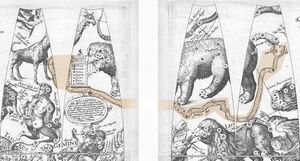
An obsolete Early Modern constellation, defined in the movement of Christianizing the sky but inconsistently: Plancius (1612) made it from eight unnamed Ptolemaic stars: Alpha and Beta CVn, Alpha, 31 and 38 Lyncis (according to Toomer), and three fainter stars of uncertain identity. Julius Schiller (1627) used it as a name for Hydra.
Etymology and History
It is the name of a (real) river with immense cultural significance, not only as a border between countries but also for several religions. The English word is a Latin loanword, derived from Semitic 'Yard|on' 'flow down' <√ירד reflecting the river's declivity (Hebrew: נְהַר הַיַּרְדֵּן, Nəhar hayYardēn, Arabic: نَهْر الْأُرْدُنّ, Nahr al-ʾUrdunn).
Constellation
The extinct constellation "Jordanus Fluvius" or "Jordanis" – the river Jordan – was invented by Petrus Plancius on his 1612 celestial globe.[1][2][3] The constellation first appeared in print in the book Usus Astronomicus Planisphaerii Stellati by Jacob Bartsch (1624), as his 26th constellation – "Iordanis" or "Iordanus". In the illustration of "Iordanis" on Bartsch's celestial globe Planisphaerium Stellatum... (1661), the star Alpha Lyncis appears as one of the prominent stars in the middle of the constellation. The extinct constellation also appeared as "Iordan" on Isaac Habrecht's (1628) Planiglobium coeleste et terrestre, "Fluvius Jordanis" in Carel Allard's (1708) Planisphaerii Coelestis Hemisphaerium Septentrionale and "Ior-Dan" in Corbinianus Thomas' (1730) Mercurii philosophici firmamentum firmianum. John Barentine (2016) notes that most of the area of Jordanis (and its aliases) was carved up in Hevelius's Lynx, Leo Minor, and Canes Venatici, which were subsequently adopted as constellations by the IAU in the 1920s.
Occurrence in historical maps and globes
- van den Keere, Pieter & Plancius, Petrus 1612, celestial globe.[4]
- Bartsch, Jacob, 1624, Usus Astronomicus Planisphaerii Stellati, p. 57.
- Habrecht, Isaac, 1628, Planiglobium coeleste et terrestre, Figura I.[5]
- Cellarius, Andreas, 1660, Harmonia Macrocosmica, Plates 24, 25 & 26.[6]
- Royer, Augustin, 1679, Cartes du ciel reduites en quatre tables.[7]
- Brunacci, Francesco, 1687, Planisfero del Globo Celeste Arctico & Antarctico.[8]
- Coronelli, Vincenzo, 1692, Planisfero Settentrionale, corretto, et accresciuto di molte Stelle,[9] also on his celestial globes dated 1693 & 1696.[10]
- Allard, Carel, 1708, Planisphaerii Coelestis Hemisphaerium Septentrionale.[11]
- Thomas, Corbinianus, 1730, Mercurii philosophici firmamentum firmianum, Frankfurt/Leipzig.
Transformation of Constellation
The eight 'external' stars south of Ursa Major in Dürer's star chart 1515, described by Ian Ridpath (highlighted by SMH).
Jordanus constellation (highlighted) in Habrecht, Isaak, Planiglobium coeleste ac terrestre (1666).
Image of the river with its direction of flow reversed by Johann Ludwig Andreae (1724) with description by Ian Ridpath
Mythology / Cultural Significance
The Jordan River. Modified from MAP Cross-checked with other maps, especially in the area of the Hula swamp and the tributaries (see Wikicommons).
Arabic Names of the Stars in Jordanus
al-Ẓibā’ in Paul Kunitzsch, Untersuchungen zur Sternnomenklatur, 1961.
* 21a. awlād aẓ-Ẓibā’, p. 39:
„die Jungen der Gazellen“. Ibn Qutayba 67, 1 (bei den unter Mondstation 14 mitbehandelten Sternen): kawākib ṣiġār fī-mā bayna ẓ-ẓibā’ wa-l-qafazāt „kleine Sterne zwischen aẓ-ẓibā’ [nr. 329] und al-qafazāt [nr. 211a]“. Ṣūfī 34, 1f. und 18‒20 zählt besonders den 5. bis 8. externen Stern im ptolemäischen Bildes Großer Bär = Fl. 10 Leonis Minoris; IX, 115; VIII, 245; Fl. 31 Lyncis hierzu, sowie all die zahllosen Sterne, die schwächer sind als Größe sechs und die Ptolemäus nicht angeführt hat.
English: 'the young of the gazelles’. Ibn Qutayba 67, 1 (for the stars treated under lunar station 14): kawākib ṣiġār fī-mā bayna ẓ-ẓibā‘ wa-l-qafazāt “small stars between aẓ-ẓibā” [no. 329] and al-qafazāt [no. 211a]’. Ṣūfī 34, 1f. and 18-20 counts especially the 5th to 8th external star in the Ptolemaic image Great Bear = Fl. 10 Leonis Minoris; IX, 115; VIII, 245; Fl. 31 Lyncis, as well as all the countless stars that are fainter than magnitude six and that Prolemy did not mention.
* 329. aẓ-Ẓibā’, p. 120:
„die Gazellen“. Ibn Qutayba 66, 11 (bei den unter Mondstation 14 mitbehandelten Sternen): kawākib mustaṭīla asfal min qafazāt aẓ-ẓibā’ „der Länge nach angeordnete Sterne unterhalb von qafazāt aẓ-ẓibā’ [= ικλμνξ Ursa Majoris]“; Ṣūfī 33,7 identifiziert aẓ-ẓibā’ mit den Sternen auf Brauen, Augen, Ohren und Maul des ptolemäischen Bildes Großer Bär (d. h. der 4., 5., 2., 3., 6. und 1. Stern) = ρο2Aπ2σ2dο Ursae Majoris, wozu er 33, 19‒34, 2 noch den 8., 3., und 4. externen des Großen Bären = Fl. 31, 40 (α), 38 Lyncis hinzunimmt. Nur die letzteren drei stimmen mit der anwā’ Definition „unterhalb von qafazāt aẓ-ẓibā’” überein.
English: ‘the gazelles’. Ibn Qutayba 66, 11 (for the stars treated under lunar station 14): kawākib mustaṭīla asfal min qafazāt aẓ-ẓibā‘ “stars arranged lengthwise below qafazāt aẓ-ẓibā” [= ικλμνξ Ursa Majoris]’; Ṣūfī 33,7 identifies aẓ-ẓibā with the stars on the brows, eyes, ears and mouth of the Ptolemaic image Great Bear (i.e. the 4th, 5th, 2nd, 3rd, 6th and 1st stars). i.e. the 4th, 5th, 2nd, 3rd, 6th and 1st star) = ρο2Aπ2σ2dο Ursae Majoris, to which he adds 33, 19-34, 2 the 8th, 3rd and 4th exterior of the Great Bear = Fl. 31, 40 (α), 38 Lynis. Only the latter three agree with the anwā‘ definition “below qafazāt aẓ-ẓibā”’.
al-Ẓibā’ in Danielle Adams, Rain Stars Set, Lunar Stations Rise, 2018, p. 102.
"Both Ibn Qutayba and al-Marzūqī report that the Gazelles themselves [al-ẓibāʾ] were represented by an elongated line of stars located below their Leaps, with the Offspring of the Gazelles (awlād al-ẓibāʾ) as the very faint stars that lie between the Gazelles and their Leaps (Ibn Qutayba 1956, 66-67; al-Marzūqī 1914, 2:374). According to al-Ṣūfī, the Gazelles leapt away from the Coarse Tail Hair of the Lion and arrived at the Watering Trough (al-ḥawḍ), which is a semicircle of stars located near the Third Leap that the other authors also describe (1981, 33; Ibn Qutayba 1956, 67; al-Marzūqī 1914, 2:374-375). Al-Ṣūfī locates the line of Gazelles in a different location near the Watering Trough, with their Offspring again being the many faint stars located nearby and extending toward the Extended Forearm of the Lion (dhirāʿ al-asad al-mabsūṭa; 1981, 33, 34)."
al-Ẓibā’ in Roland Laffitte, Le ciel des Arabes, 2012, pp. 112-113.
|
ο2ρπ2σ2d UMa +αβ CVn + α/31 Lyn | ||||
| Arabic | French | English | Author | |
| al-Ẓibā’ | les Gazelles | the Gazelles | Qutayba | |
| α Lyn | Ğanūbī ’l-Ḍibā’ [p/ al-Ẓibā’] | l’Australe des Gazelles | the southern one of the Gazelles | Miṣrī |
| 31 Lyn | Mutaq. al-Ḍibā’ [p/ al-Ẓibā’] | l’Antérieure des Gazelles | the front one of the Gazelles | Miṣrī |
| 38 Lyn | Šamālī ’l-Ḍibā’
[en fait : al-Ẓibā’] |
la Boréale des Hyènes
[en fait : les Gazelles] |
the northern one of of the Hyena | Miṣrī |
| 46, 21+β LMi | ||||
| Awlād al-Ẓibā’ | les Petits des Gazelles | the small one of the Gazelles | Qutayba | |
| Awlād al-Ġizlān | idem | Ṣūfī | ||
| τhυφθef UMa | ||||
| al-Ḥawḍ | l’Abreuvoir | the Water Trough | Qutayba | |
| al-ᶜUnq | l’Assemblée | the Meeting | Qutayba | |
| ικλμνξ UMa | ||||
| Qafazāt al-Ẓibā’ | les Sauts | the Jumps | Qutayba | |
| al-Qafazāt | les Sauts [des Gazelles] | the Jumps (of the Gazelles) | Qutayba | |
| Qafazāt al-Ġizlān | les Sauts des Gazelles | The Jumps of the Gazelles | Ṣūfī | |
| al-Qawāfiz | les Bondissantes | the Bouncings | Marzūqī | |
| Baqarāt al-Ẓibā’ | les Gazelles femelles | the female Gazelles | Fāris | |
| νξ UMa | al-Qafazat al-Ūlā | le 1er Saut | First Jump | Ṣūfī |
| λμ UMa | al-Qafazat al-Ṯāniyya | le 2nd Saut | Second Jump | Ṣūfī |
| ικ UMa | al-Qafazat al-Ṯāliṯa | le 3ème Saut | Third Jump | Ṣūfī |
| ι UMa | Šamālī ’l-Qafazat al-Ūlā
[en fait : al-Ṯāliṯa] |
la Boréale du 1er Saut
[en fait : le 3ème] |
the northern one of the first jump | Miṣrī |
| κ UMa | Ğanūbī ’l-Qafazat al-Ūlā
[en fait : al-Ṯāliṯa] |
l’Australe du Premier Saut
[en fait : le 3ème] |
the southern one of the first jump | Miṣrī |
| λ UMa | [Šamālī] ’l-Q. al-Ṯāniyya | [la Boréale] du 2nd Saut | (the northern one) of the second jump | Miṣrī |
| μ UMa | Ğanūbī ’l-Q al-Ṯāniyya | l’Australe du 2nd Saut | the southern one of the second jump | Miṣrī |
| ξ UMa | Ğanūbī ’l-Q. al-Ṯāliṯa
[en fait : al- Ūlā] |
l’Australe du 3ème Saut
[en fait le 1er] |
the southern one of the third jump | Miṣrī |
NB : Miṣrī is Nağm al-Dīn al- Miṣrī (XIVth c.), see Ğadwal maṭāliᶜ al-kawākib wa-abᶜādihā wa-ğihatihi, or "Tables of right ascensions of the stars and their declinations", accompanied by their signs [+ or -] is one of the tables in the book Kitāb fī l-ālāt al-falakiyya by Nağm al-Dīn al-Miṣrī, between 1325 and 1340. It is edited and partially translated by ms. Oxford, Bodeliean Library, Marsh 672, fol. 148v-151r, in CHARRETTE, François, Mathematical Intrumentation in Fourteenth-Century Egypt and SyriaB►, 2003, p. 360-370.
IAU Working Group Star Names
The name was suggested to the IAU WGSN to be used as a star name in 2023. Alpha and Beta CVn are already named (Cor Caroli and Chara), the brightest of the others is Alpha Lyncis (SIMBAD: 3.1 mag in V). For this star, also the star name "Xuanyuan" was suggested but rejected because of the tremendous significance of this Chinese term for the Chinese cultural heritage.
In the earliest versions of the drawing of the Jordanus River, the headwaters of the river are marked by three stars, likely to be identified with 25 CVn and 20 CVn + HR 4997. Their names on late 16th-century Dutch biblical maps[12] are Dan and Ior.[13] Thus, it is proposed to name one, two or all three stars within the obsolete constellation (NOTE: WGSN does not assign single names to pairs of stars, so select a single star per name):
- α Lyncis: "Jordanus", (SIMBAD: 3.1 mag in V)
- 25 CVn: "Ior" (SIMBAD 4.82 mag) for the sake of symmetry, or perhaps BH CVn (SIMBAD 4.94-5.1 mag VSX), but on some maps explicitly only one star here
- 20 CVn or HR 4997: "Dan" (SIMBAD 4.69 mag, SIMBAD 4.94 mag)
The above list of historical names confirms, that there are no Arabic names competing for the stars are suggested to call Ior and Dan.
The WGSN chose ... (not to apply/ to apply the name to a neighbouring star/ to ...) in the IAU-CSN.
Weblinks
- Ridpath, Ian, "Star Tales: online edition".
Reference
- ↑ Ridpath, Ian, "Star Tales: online edition".
- ↑ Barentine, John C., 2015, The Lost Constellations: A History of Obsolete, Extinct, or Forgotten Star Lore, Springer Praxis Books LINK, Chichester, UK, p. 201-216.
- ↑ Harper, David & Stockman, L.M., 2020, "Jordanus Fluvius – The River Jordan",
- ↑ Rijksmuseum link.
- ↑ ECHO link.
- ↑ Alvin link 1, Alvin link 2, Alvin link 3.
- ↑ Gallica link 1, Gallica link 2.
- ↑ Gallica link.
- ↑ Gallica link 1, Gallica link 2.
- ↑ Gallica link 1, Gallica link 2.
- ↑ Rijksmuseum link.
- ↑ In 1590 Petrus Plancius designed a set of biblical maps, engraved by Johannes van Deutecom and his sons Baptista and Johannes, to illustrate a new edition of the so-called Deux-Aes Bible printed by the Amsterdam publisher Laurens Jacobszoon. The map of the Holy Land in this set distinctly marks the headwaters of the Jordan River as Dan fons and Ior fons. Later editions of these maps were embellished by adding a border with biblical scenes. See example 1, example 2.
- ↑ The names Ior and Dan as the headwaters of the Jordan River appear to have originated in European pilgrim narratives and chronicles in the times of the Crusades. Cf. George Adam Smith, The Historical Geography of the Holy Land, Especially in Relation to the History of Israel and of the Early Church (New York: A.C. Armstrong and Son, 1895), p. 472 [note 1] [Internet Archive link].


